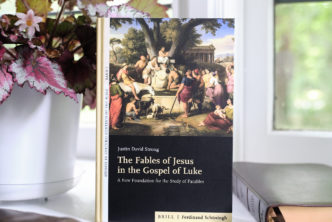Book Review
Kent L. Yinger, Cascade Books, 2011, 120 pp.
Kent L. Yinger’s The New Perspective on Paul: An Introduction is as accessible as it is academically sound. In only 120 pages he outlines and illustrates nearly every aspect of the new perspective; it is in fact almost too brief at points, but generally strikes a good balance between erudition and conciseness. Don Garlington sums up the volume well in his afterword:
Professor Kent Yinger has favored us with the finest introduction to the New Perspective on Paul (NPP) to date. Within the scope of relatively few pages, he has outlined the arguments pro and con in a fair and balanced manner and in a style that makes for easy reading for the non-specialist in the field (p. 101).
Yinger approaches the topic in eight chapters by considering four basic questions about the new perspective, outlined in the first chapter:
- What is it?
- Where did it come from?
- What are the potential dangers?
- What good is it?
The second chapter explains E.P. Sanders’ work regarding covenantal nomism, articulating the current consensus that Second Temple Judaism was not a religion of legalism. The third chapter follows naturally with a description of J.D.G. Dunn’s articulation of the new perspective.
The fourth chapter is particularly interesting in its description of variations since Dunn; it begins with a description of N.T. Wright’s position (pp. 27-30), outlines in clear detail the Sanders-Dunn-Wright trajectory (pp. 30,31), and touches briefly on the works of others, including Don Garlington and himself (pp. 31,32), Francis Watson’s earlier sociological approach (pp. 32,33), and Heikki Räisänen’s non-systematic approach (pp. 33,34). It goes on to describe the later trend of Paul and Empire (pp. 34,35) and even the approach of Paul within Judaism (pp. 35,36). These last two categories reflect distinctions that are currently made on The Paul Page as well.
Perhaps the biggest oversight in the general category of Paul within Judaism is the focus on only the Christian scholars John Gager and Lloyd Gaston and a “two covenant” approach; some mention of Jewish scholars, such as Pamela Eisenbaum and Mark Nanos, would have been appropriate. Neither is there any mention in this chapter of the more recent Leuven approach which relies more heavily on Sanders’ proposed discontinuity between Judaism and Paul, but it may perhaps be unfair to expect a more thorough treatment from such a brief volume. The chapter ends by setting the stage for a discussion of controversies surrounding the new perspective.
Chapter five describes the challenge which more traditional interpreters of Paul have mounted against Sanders’ description of covenantal nomism. Chapter six details points of exegetical (interpretative) debate, chapter seven details points of theological debate, and chapter eight helpfully ties together the remaining loose ends in a generally positive assessment of the new perspective. This is not to say that Yinger’s description of the controversies is one-sided; he does a masterful job of describing the positions of both critics and proponents while pointing the reader to additional reading material for further study. Of some note is the fact that the criticisms detailed are generally from the more conservative Christian side; criticisms of the new perspective from other angles, such as those posed by Nanos, go unmentioned.
Within the boundaries that are explored in chapters five through eight, however, the book is surprisingly thorough, touching not only on Christian debates about covenantal nomism (pp. 39-46) but a wide variety of issues: works of law (pp. 48-50), call vs. conversion (pp. 50-54), the question of Paul’s introspective conscience (pp. 56-58), the description of Paul as a sinner (pp. 59,60), the debate about whether pistis christou should be rendered “faith in Christ” or “faith of Christ” (pp. 69,70), and of course several key texts (Gal. 3:10-13, pp. 54-56; Phil. 3:6, pp. 58,59; Rom. 7, pp. 60-63; Rom. 10:3, pp. 63-65; Rom. 4:1-5, pp. 65-67; and disputed Pauline texts, pp. 67-69, with a helpful citation from this reviewer).
When Yinger turns to theological considerations, he clearly and concisely articulates the issues between new perspective scholars and their conservative Reformed critics. Recognizing the diversity of viewpoints within the new perspective, for instance, Yinger writes that “Some NPP writers do, in fact, see their stance as challenging, or even overturning, the central insights of the Protestant Reformation. Others most definitely do not” (p. 72). In articulating the concerns of critics and the responses of new perspective scholars, Yinger is very fair. Describing concerns over legalism:
Critics fear that the NPP slips in legalism through a side door; NPP writers do not typically approve of legalism, but contend that particular passages in Paul deal with something else (p. 50).
According to critics:
The NPP makes Paul soft on legalism. Not so fast, protest NPP proponents. True, Paul is not opposing good deeds in the verses normally cited on this point. But that certainly does not mean he now favors salvation by works. … Even if Paul does not polemicize against legalism in the verses normally cited, this does not mean he wouldn’t have done so given the opportunity. Legalism simply wasn’t the issue confronting him in his churches, and thus we find little opposition to it in his letters (p. 80; cp. pp. 57,58).
But Yinger doesn’t stop there. He goes on to describe a key reason for some of the misunderstandings:
The concerns of critics arise largely from the realms of church history and systematic theology, not directly from biblical studies. But NPP writers usually see themselves as biblical scholars, and less as theologians (p. 84).
It is also worth reminding readers that the NPP is primarily a matter of NT interpretation, of biblical studies. The concerns of its proponents are first of all, and sometimes solely, issues of “What did Paul say and mean?” rather than pastoral questions (“How will this affect ministry and Christian experience today?”, p. 78).
Yinger considers arguments surrounding justification by faith alone (pp. 73,74), forensic justification (pp. 74,75), imputed righteousness (pp. 75-77), legalism (pp. 77-79,80), assurance (pp. 79-80), ecumenism (pp. 81,82), synergism (pp. 82,83), and individual salvation (pp. 83,84).
In Yinger’s concluding chapter, he details positive effects of the new perspective: A better understanding of Paul’s letters (pp. 87,88), a reduction of western individualism (p. 88), a concern over anti-semitism (wherein he grapples honestly with the problem of supersessionism, i.e., the replacement of Israel by the church, pp. 88,89), continuity between the testaments (pp. 89,90), continuity between Jesus and Paul (pp. 90-92), and finally ecumenism (pp. 92,93). This is followed by two responses: A more traditional criticism by Donald A. Hagner (pp. 95-100) and a very articulate afterword by Don Garlington (pp. 101-105). A bibliographic listing of works cited, an annotated bibliography for further study, and a subject index help to flesh out this extremely useful little book.
One final constructive criticism is in order. In 1986, Francis Watson’s book Paul, Judaism, and the Gentiles: A Sociological Approach was published. This book clearly reflected the new perspective on Paul. However, Watson later changed his mind and wrote another book with the same title, but a different subtitle: Paul, Judaism, and the Gentiles: Beyond the New Perspective. This book was published in 2007. Both books are cited in the bibliography. However, in the text of the book, the two titles are not distinguished, which may create some confusion for the reader. The first reference to Watson is to the earlier volume (p. 33, n.10). The second reference comes twelve pages later with the term “idem,” meaning the same volume (p. 45, n. 13), but in fact the reference is to the later volume. The remaining references (p. 49, n. 2; p. 72, n. 4) are to the earlier volume. Perhaps this discrepancy can be remedied in the next edition.
On the whole, however, The New Perspective on Paul: An Introduction is an extremely useful reference tool which should help to clarify complex issues for countless readers for years to come.
Mark M. Mattison




In terms of Saul’s “call or conversion” referred to, there is a third option: that Saul’s immediate experience and subsequent experiences fall directly in line with the conditions of the Post-Traumatic Stress Syndrome. Now that is a really new – and, I believe, helpful – perspective.
Bob Collie
http://theapostlepaulandposttraumaticstress.blogspot.com/
[…] from links and article reprints to useful bibliographies and book reviews. (For example, here is Mattison’s review of Yinger’s introduction to the NPP, which I mentioned in my last blog post.) Mattison’s own summary of the New […]